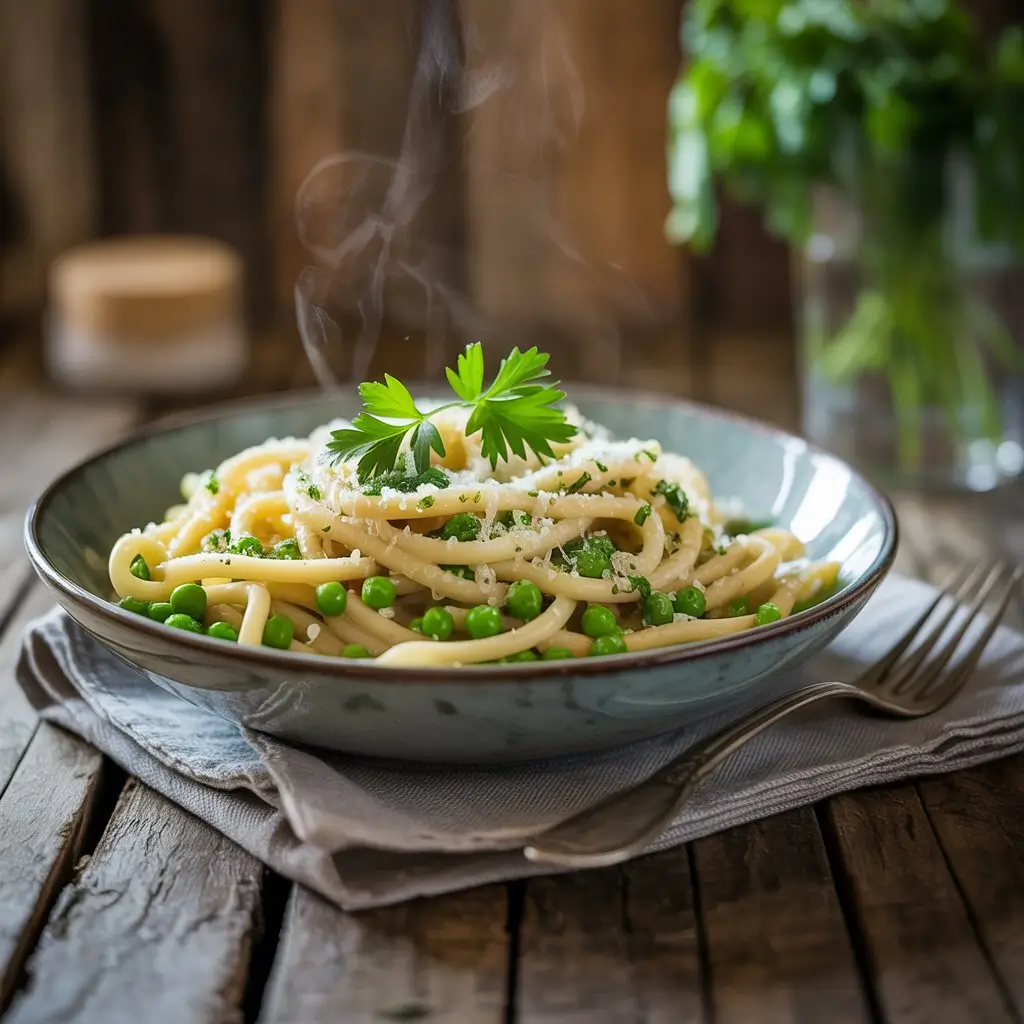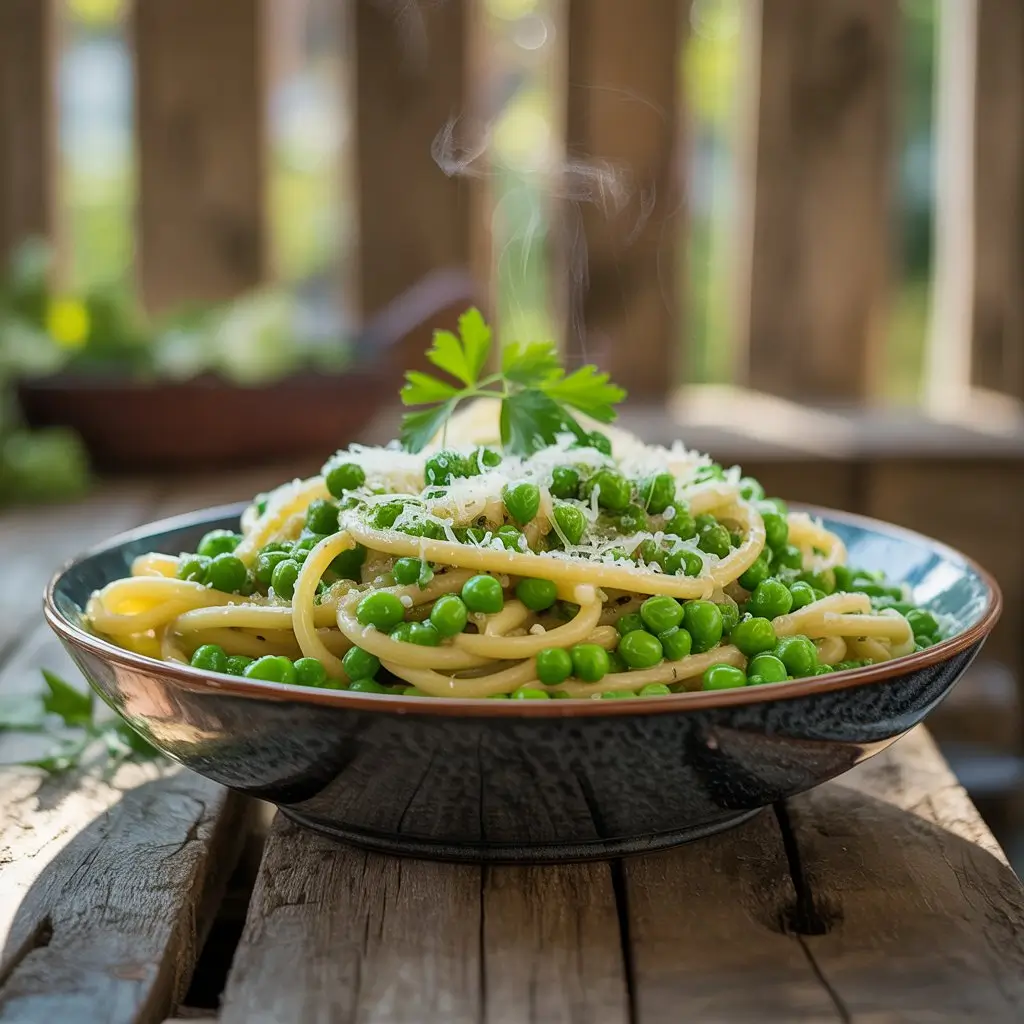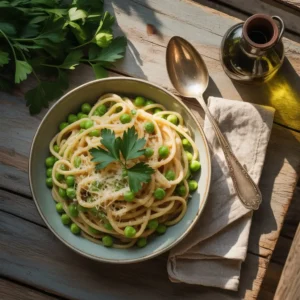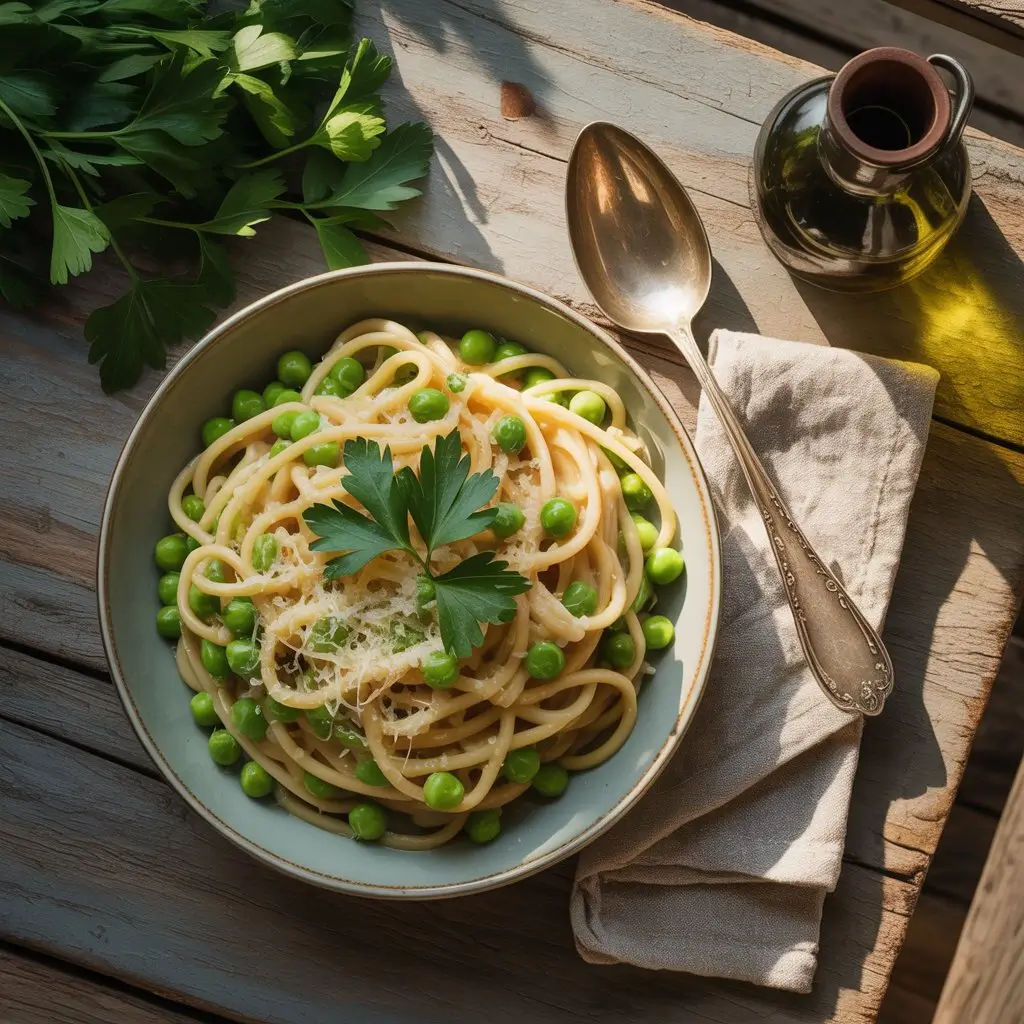Introduction
Craving something cozy, quick, and full of flavor? Look no further than pasta and peas, a comforting classic that brings simplicity and soul to your lunch table. This humble dish, rooted in traditional Italian kitchens, has found fans around the globe for one reason: it just works.
To begin with, it comes together with pantry staples, so there’s no need for a special grocery trip. Moreover, it satisfies both hunger and heart, making it perfect for those midday meals when you want something warm and grounding. Unlike complex recipes that require hours of prep, this one-pot wonder takes minimal effort and delivers maximum flavor.
In short, pasta and peas are more than a meal; it’s a gentle reminder that good food doesn’t have to be complicated. Whether you’re a busy professional, a home cook exploring new favorites, or a student with limited ingredients, this dish welcomes you with open arms and a delicious aroma.
Why Pasta and Peas Deserves a Spot in Your Lunch Rotation
First and foremost, the appeal of pasta and peas lies in its balance of ease and satisfaction. It’s one of those rare meals that manages to feel indulgent without being heavy. Not only that, but it’s also naturally vegetarian and full of fiber and plant-based protein from the peas.
Furthermore, it’s incredibly adaptable. You can add cheese, a splash of cream, or even spice it up with chili flakes. If you’re watching your grocery budget, you’ll love that this dish uses inexpensive, readily available ingredients — many of which you probably already have.
In addition, it’s ideal for meal prepping. Cook once, and you have lunch for several days. As a result, you’ll save both time and money throughout your week.
Pasta and peas check all the boxes: comforting, nutritious, quick to make, and kind to your wallet. It’s no surprise it continues to earn a loyal place on lunch menus around the world.

Ingredients You’ll Need for Pasta and Peas
Before diving into the cooking process, let’s start with the essentials. This simple dish doesn’t ask for much, which makes it even more appealing. With just a few ingredients, you can create a heartwarming, flavor-rich lunch that’s both satisfying and wholesome.
Here’s what you’ll need:
| Ingredient | Quantity | Notes |
|---|---|---|
| Pasta | 1 cup | Choose small shapes like ditalini, elbow macaroni, or small shells |
| Green peas | 1 cup | Frozen peas work beautifully, but fresh is also great |
| Olive oil | 2 tablespoons | Use extra virgin for the best flavor |
| Onion | 1 small | Finely chopped for a sweet and savory base |
| Garlic | 2 cloves | Minced; fresh garlic gives the best aroma |
| Vegetable broth | 3 cups | Low-sodium preferred; can substitute water and bouillon |
| Parmesan cheese | ½ cup | Freshly grated; optional for a richer taste |
| Salt | To taste | Start with a pinch, adjust as you go |
| Black pepper | To taste | Freshly ground for added depth |
| Fresh parsley | 2 tablespoons | Chopped, for garnish and color |
As you can see, these ingredients are kitchen staples. Therefore, this recipe is perfect for those days when your pantry is running low, but you still want a cozy, nourishing dish.
Step-by-Step Instructions to Make Pasta and Peas
Now that you’ve gathered your ingredients, let’s move on to the fun part — cooking! This one-pot meal comes together quickly and effortlessly. Follow these steps carefully, and you’ll have a warm bowl of pasta and peas ready in no time.
Sauté the Onion and Garlic
To begin with, heat the olive oil in a medium-sized pot over medium heat. Once the oil shimmers, add the chopped onion. Stir occasionally, cooking it until soft and golden — about 5 minutes.
Next, toss in the minced garlic and sauté for about 1 minute. Be careful not to burn it, as burnt garlic can turn bitter. The mixture should smell fragrant and inviting.
Add the Peas and Simmer
After that, add the green peas to the pot and stir to coat them in the aromatic oil and onion mixture. Then, pour in the vegetable broth and bring everything to a gentle boil.
Let the mixture simmer for 5–7 minutes, which allows the peas to soften and infuse the broth with a subtly sweet flavor. If using frozen peas, there’s no need to thaw them beforehand.
Add Pasta to the Pot
Once the broth is simmering, stir in the pasta. There’s no need to cook it separately, this is what makes it a true one-pot dish. The pasta will cook right in the broth, soaking up all the delicious flavors along the way.
Make sure to stir occasionally so the pasta doesn’t stick to the bottom. Depending on your pasta type, cooking should take 8–10 minutes. Taste a piece to check for doneness; it should be tender but still slightly firm.
Season and Stir in Cheese (Optional)
At this point, taste the broth and season with salt and freshly cracked black pepper to your liking. If you’re using Parmesan cheese, stir it in now. As a result, the cheese melts into the broth, creating a slightly creamy texture and adding umami depth.
Let it Rest and Serve
Finally, turn off the heat and let the pasta sit for a minute. This resting time allows the flavors to come together and the broth to thicken just a bit more.
To serve, ladle the pasta and peas into bowls. Drizzle with a little more olive oil, sprinkle with chopped fresh parsley, and top with extra Parmesan if desired.
There you have it, a warm, comforting bowl of pasta and peas, ready to be enjoyed.

Pro Tips to Elevate Your Pasta and Peas
Even though the recipe is simple, a few chef-level tips can take your pasta and peas from comforting to downright unforgettable. With that in mind, here are some helpful pointers to make every bite even better:
Use the Right Pasta Shape
First of all, not all pasta is created equal for this dish. Stick with small, tube-like shapes such as ditalini, elbows, or even tiny shells. Why? These shapes cook quickly and trap the peas and broth, giving you perfect spoonfuls every time.
Don’t Overcook the Pasta
While it might be tempting to walk away, stay close as your pasta cooks. Overcooking can lead to a mushy texture. Instead, aim for al dente — tender but with a slight bite — to keep the dish light and satisfying.
Balance the Broth
Depending on your preference, you can make your pasta and peas more soupy or thicker. If you prefer a brothy bowl, add an extra half-cup of broth before adding the pasta. For a thicker stew-like texture, let it simmer a bit longer uncovered.
Add Cheese Strategically
Parmesan cheese adds magic, but timing matters. Stir it in after the pasta is fully cooked and just before serving. Consequently, you get the creamy, savory punch without clumps or curdling.
Finish with a Drizzle of Olive Oil
To enhance flavor and texture, drizzle a touch of high-quality extra virgin olive oil on top just before serving. It adds a smooth richness and elevates the entire dish.
Cook in Layers of Flavor
Lastly, seasoning at different stages — when sautéing onions, after adding broth, and again before serving- helps build a deeper, more rounded taste.
Delicious Variations You’ll Want to Try
Although the classic pasta and peas recipe is perfect as-is, sometimes a little twist can keep things fresh and exciting. Here are several creative spins on the traditional version, perfect for customizing to your taste or dietary needs.
Creamy Pasta and Peas
For a decadent touch, stir in a splash of heavy cream or a tablespoon of mascarpone cheese after the pasta finishes cooking. As a result, you’ll get a velvety, luscious texture that feels like an indulgent treat.
Lemon Zest and Fresh Herbs
If you’re craving freshness, try adding a teaspoon of lemon zest and a few torn basil leaves at the end. This combination brightens the dish, making it perfect for spring and summer lunches.
Spicy Kick with Red Pepper Flakes
Want to turn up the heat? Sprinkle red pepper flakes while sautéing the garlic for a gentle warmth that lingers on the palate. It’s subtle, yet powerful.
Add Protein for a Heartier Meal
In case you want more sustenance, mix in cooked pancetta, crispy bacon, shredded chicken, or even sautéed mushrooms. Alternatively, for a plant-based boost, add chickpeas, cannellini beans, or tofu cubes.
Gluten-Free or Low-Carb Options
If you’re gluten-sensitive, simply swap in a gluten-free pasta. Or, for a low-carb version, try spiralized zucchini or cauliflower rice — though the texture will be different, the flavor remains delightful.
Italian-Inspired Flavors
To enhance authenticity, throw in a pinch of dried oregano or a bay leaf while the broth simmers. These subtle additions echo classic Italian flavors and deepen the savory base.
Frozen Spinach or Kale Add-In
Need an extra veggie boost? Stir in a handful of chopped spinach or kale during the last few minutes of cooking. Not only will this up the nutrition, but it adds a pop of green and a new layer of flavor.
Together, these pro tips and variations make your pasta and peas endlessly customizable. Whether you’re in the mood for comfort, spice, or freshness, there’s a version just waiting to be your new favorite.

Why This Pasta and Peas Recipe Works for Everyone
When it comes to universally appealing meals, few dishes check as many boxes as pasta and peas. It’s cozy yet quick, familiar yet flexible — and that’s precisely what makes it a staple in kitchens worldwide.
To begin with, it suits nearly every lifestyle. From vegetarians and busy parents to budget-conscious students and health-aware eaters, this meal fits in effortlessly. Because it uses affordable, accessible ingredients, you won’t have to go hunting for specialty items or spend extra money.
Moreover, it’s highly adaptable. Prefer something creamier? Add cheese or cream. Need more protein? Throw in beans or chicken. Avoiding gluten? Swap in gluten-free pasta. In other words, it’s a crowd-pleaser without the stress.
What’s more, it doesn’t sacrifice flavor for ease. The combination of sautéed onion, garlic, sweet peas, and savory broth creates a flavor profile that’s both comforting and deeply satisfying. Even picky eaters often find themselves going back for seconds.
All in all, whether you’re feeding a family, prepping weekday lunches, or seeking something soothing for a solo meal, this recipe delivers every single time.
How to Store and Reheat Leftovers pasta and peas
As delicious as this dish is fresh, it also makes excellent leftovers — which means it’s perfect for meal prepping or next-day lunches.
Storage Tips
- Once cooled completely, transfer the pasta and peas to an airtight container.
- Refrigerate for up to 3 days.
- Avoid freezing, as the pasta can become mushy upon thawing.
Reheating Instructions
When it’s time to enjoy the leftovers, you’ll want to restore that comforting texture and flavor:
- Stovetop: Place in a saucepan with a splash of vegetable broth or water. Heat over medium-low, stirring occasionally until warm.
- Microwave: In a microwave-safe bowl, add a spoonful of water or broth. Cover with a lid or damp paper towel. Heat on medium for 1–2 minutes, stirring halfway through.
Pro tip: Always reheat just what you need. Repeated reheating can affect texture.
Nutrition Facts for pasta and peas (Per Serving Estimate)
For those keeping an eye on nutrition, here’s an approximate breakdown for one serving of pasta and peas (without cheese):
| Nutrient | Amount |
|---|---|
| Calories | 290 kcal |
| Carbohydrates | 42g |
| Protein | 10g |
| Fat | 10g |
| Saturated Fat | 1.5g |
| Fiber | 5g |
| Sugars | 4g |
| Sodium | 460mg |
| Cholesterol | 0mg |
Please note: These values are estimates and can vary based on ingredient brands and specific modifications. If you add cheese, cream, or meat, the calorie and fat content will increase slightly, but so will the protein and richness!
Conclusion for the Pasta and Peas Recipe
In the fast-paced rhythm of everyday life, finding a recipe that’s easy, comforting, and adaptable is like striking gold. Without a doubt, pasta and peas is that golden dish. It’s hearty enough to satisfy, simple enough for beginners, and versatile enough to evolve with your tastes and dietary needs.
Whether you’re cooking for one or feeding a crowd, this recipe offers warmth, nutrition, and a familiar flavor that never goes out of style. From its humble ingredients to its rich, savory broth, every spoonful feels like home, no matter where in the world you are.
Now it’s your turn. Try it for your next lunch, dress it up with your favorite add-ins, or keep it beautifully basic. Either way, you’re guaranteed a meal that’s both filling and flavorful.
👉 Did you try this pasta and peas recipe?
We’d love to hear how it turned out for you! Share your twist in the comments below, or tag us on social media with your delicious creations. And don’t forget to share this post with a fellow food lover — good food is always better when it’s shared!
FAQs
Yes, but add them later in the cooking process to avoid mushiness.
Ditalini, macaroni, or small shells work best as they soak up the broth.
Absolutely! Substitute with gluten-free pasta without changing the other ingredients.
It’s best enjoyed fresh. Freezing can alter the texture of the pasta, making it mushy.
Sure! Bacon, pancetta, or sausage make flavorful additions. Just sauté them first.
Stir in a splash of cream or a tablespoon of mascarpone at the end for a rich finish.

Irresistibly Easy Pasta and Peas Recipe for a Comforting Global Lunch
Equipment
- Medium saucepan or soup pot
- Wooden spoon or spatula
- Knife and Cutting Board
- Measuring Cups and Spoons
- Ladle for serving
- Grater (if using fresh Parmesan)
Ingredients
- 1 cup Small pasta (ditalini, macaroni, or shells)
- 1 cup Green peas (frozen or fresh)
- 2 tbsp Olive oil
- 1 small Onion, chopped
- 2 Garlic cloves, minced
- 3 cups Vegetable broth
- Salt and black pepper to taste
- ½ cup Grated Parmesan and fresh parsley Optional
Instructions
- Sauté aromatics: In olive oil, cook onion until soft. Add garlic and stir briefly.

- Add peas & broth: Stir in peas, then pour in broth and simmer for 5–7 minutes.

- Add pasta: Stir in uncooked pasta and cook in the broth until al dente (8–10 mins).

- Season & finish: Add salt, pepper, and Parmesan (if using). Let it rest briefly.

- Garnish & serve: Top with parsley and a drizzle of olive oil. Serve hot and enjoy!






